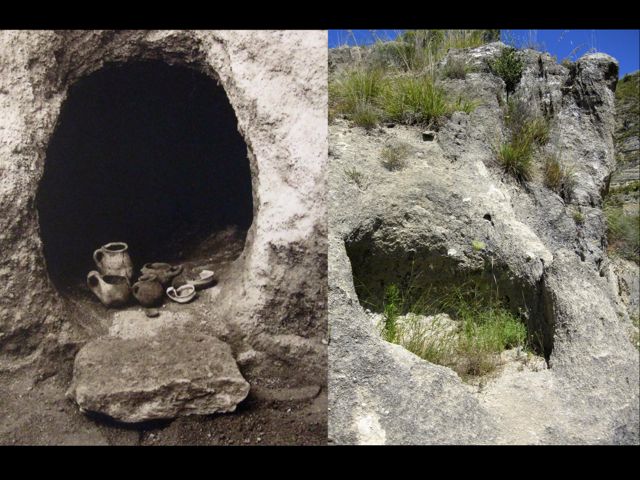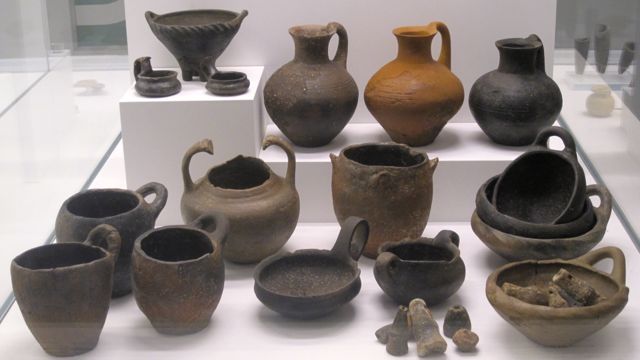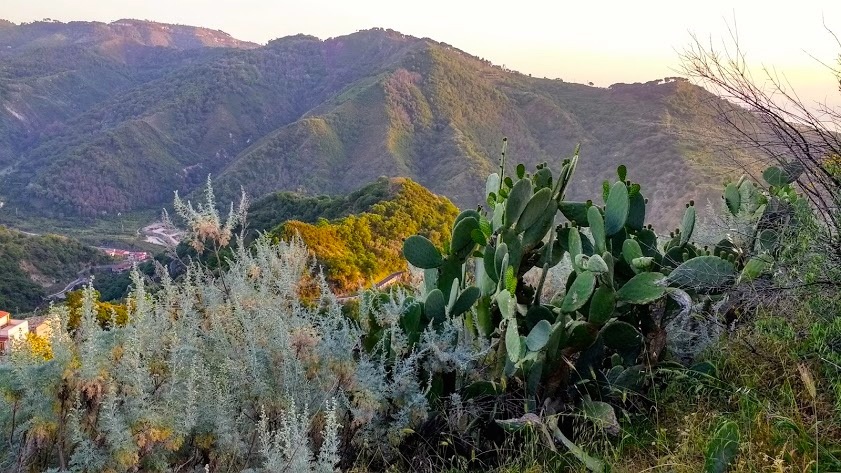In Italy, you can’t put a shovel to the ground or duck underwater off the coast without running into something old. And I’m not talking about the age of the objects paraded in front of the Antiques Roadshow camera. I mean ancient. Some discoveries, like the Riace Bronzes, are world-shaking. Others would be front-page news most anywhere but Italy. The region of Calabria has more than its share of treasures and in the small town of Calanna in the Province of Reggio Calabria, they date back to the Iron Age.
IRON AGE TOMBS IN CALABRIA

Along the road near the tombs in Calanna
These artifacts are noteworthy, even for an area in which there is archeological evidence of traffic passing through its waters from the Neolithic Period, which would be at the end of the Stone Age. There’s no getting around the fact that the Strait of Messina was and is an important passageway, and the town of Calanna has it in its sights, and then some, with an expansive view of the sea, the Sicilian coastline, and on a clear day Mt. Etna, from its position on a hill about 20 kilometers north of Reggio.

Strait of Messina as seen from Calanna
As often is the case, the Iron Age tombs in Calanna were discovered during construction. This was back in the 1950s. The public road works were halted and the excavation uncovered numerous tombs in the shape of little grottos carved out of the limestone rock along a gully. Small stone slabs covered the burial chambers that dated from the 13th to the 7th centuries BC, and inside, the skeletons were arranged in fetal position together with their grave goods.

Iron Age Gully in Calanna

Iron Age Tombs in Calanna – on left, with funerary objects in 1950s; on right, today
Several of the funerary objects were put on display in the Archeological Museum in Reggio Calabria, and there is still a case on the ground floor with artifacts found in a female tomb from the 8th-century BC.

Funerary objects from Iron Age female tomb in Calanna, 8th-century BC, at Archeological Museum in Reggio Calabria
NEW MUSEUM IN CALANNA

Exhibit Space at Calanna Archeological Museum
This past spring a new archeological museum was inaugurated in Calanna and I went for the ribbon cutting. Quite a crowd turned out with parking all along that fateful road constructed in the middle of the last century. The sun was almost overwhelming during the many speeches of the various dignitaries in attendance at the outdoor ceremony on a late afternoon in early May. I suppose I shouldn’t have been surprised by the positive comments in that regard from the locals who were pleased to have the opportunity to get a start on their summer tans.

Calanna Archeological Museum
Finally, the ribbon was cut and groups eagerly entered to view the nicely laid out town archeological museum in its brand new building across from the area of the tombs. Sleek display cases exhibited a range of Iron Age items: clay jars, pots, pitchers, wine cups and spools, metal clothing clasps and rings, and even a small, amber jewelry piece.

Clay and metal Iron Age artifacts
My favorite of the Neolithic objects was a little terracotta-footed vase with handles; the slightly off-kilter angle added to its charm. What might have been intended as contents of this miniature container?

Footed Iron Age Vase
The museum also housed several objects from much later periods. For example, colorful, broken pottery from the 15th-17th centuries AD came from the area of the castle, the remains of which could be seen on the top of a hill across from the museum.
The collection also has two Byzantine objects of note, one of which was uncovered in another necropolis nearby. Dated very roughly between the 6th and 9th centuries AD, this bronze pectoral cross has an image of the mother and child with the words “Mother of God” in Greek etched into it. The Proloco Calanna, the local association that promotes the town, has adopted the cross as its logo. The other significant relic from the Byzantine period is an amulet of St. George sculpted in light-green soapstone. This ornamental talisman comes from around the time that Reggio beat back the Saracens and adopted St. George as their patron saint. The Arabs had attacked the coastline for years and this victory in 1086 was attributed to the intervention and protection of St. George.

Byzantine cross and St. George amulet
VISITING CALANNA

Iron Age Pottery in Calanna Museum
Towns such as Calanna, with documented evidence of inhabitance over many historical periods, give the sense of continuity. The 1,000-odd people living there today descend from at least three thousand years of human activity. Archeologists study the artifacts found in the Iron Age tombs to explore the customs of the indigenous people, to determine the point at which the community was influenced by those living across the Strait in eastern Sicily and then by the Greeks who would settle throughout Southern Italy. On a hill across from the tombs are the remains of numerous 19th-century kilns. Not long ago the women of Calanna went to communal fountains with large clay pots balanced on their heads. Today, there’s running water in every home, but the population drinks their water out of plastic bottles, artifacts of the future.
The area of the tombs is in what’s known as Contrada (or district) Ronzo, just off the road before the museum. The countryside is hilly and rugged with jutting, whitish rock and patches of olive green foliage. The remains of the tombs amidst the craggy sandstone cliffs, weathered and shaped by wind and man’s digging, are accessible to the public.
The museum doesn’t have regular hours at this time, so best to contact the Proloco in advance of a visit (proloco_calanna@virgilio.it or 334/7705343). Do you have plans to be in the area at Christmastime? Calanna is also known for its Presepe Vivente or Live Nativity.
 Interested in more of what there is to see and do in Reggio Calabria, the beautiful city right at the point of the toe in the Italian boot? Check out Calabria: The Other Italy, my non-fiction book about daily life, history, culture, art, food and society in this fascinating southern Italian region.
Interested in more of what there is to see and do in Reggio Calabria, the beautiful city right at the point of the toe in the Italian boot? Check out Calabria: The Other Italy, my non-fiction book about daily life, history, culture, art, food and society in this fascinating southern Italian region.
In addition, my blog has several posts about museums in Reggio: Reflection on the Riace Bronzes, The Archeological Museum in Reggio Calabria – Much More than the Famous Bronzes, The Bergamot Museum, Pinacoteca Civica, Art Museum of Reggio Calabria, The Palazzo della Cultura in Reggio Calabria and Museo San Paolo. And in the very northwest of the region, don’t miss the Grotta del Romito, a prehistoric art and grave site in the Pollino Mountains.
“Like” Calabria: The Other Italy’s Facebook page and follow me on Karen’s Instagram and Karen’s Twitter for more beautiful pictures and information.
Sign up below to receive the next blog post directly to your email.
CALABRIA: THE OTHER ITALY makes a great gift!

Comments 12
What a joy to see a post about a place in Calabria that is absolutely marvelous and off the beaten path. Kudos! Calabria is coming a long way, still has a long road to haul, but so many gems undiscovered. Oh? And the cave houses and the “castle”? A real gem, well worth the time to enjoy the ride and discover “real” Italy!
Author
Thank you for your nice comment. Calabria certainly has something worthy of discovery around every corner. Yesterday I had to laugh at a blogpost I was reading in which the person talked about Tuscany’s Arezzo as if it were “off the beaten path.” So, if Arezzo, well known for its beautiful churches, film location of Life is Beautiful and not to mention the famous medieval musicologist Guido of Arezzo, is a hidden gem, what must Calanna or even a better-known site in Calabria be?
I think it depends on the pov and the target audience. For the majority of people, something like Arezzo is off-the-beaten-path. Classic destinations are just Rome, Venice, Florence and Costiera Amalfitana :\
(Some years ago I went to Arezzo and when I told my professor about my trip, she said: “Arezzo? Is there even something to see in Arezzo?”..and yeah, she was a cultured woman :\ )
Author
Ha, ha, yes, you’re right. I suppose I don’ think of Italy in terms of the big 3 or 4 destinations. For me, #20, whatever that might be, wouldn’t be off the beaten path.
Very interesting article …….. and, ‘yes’ , Calanna REALLY is “off the beaten path”!!! The artifacts are very beautiful. It is amazing, that after ALL those past centuries, they were still able to recover & restore them to their original conditions!
Your blogs ALWAYS have such interesting information AND photos!
Many thanks!
Author
Thank you so much! These ancient artifacts were well-preserved in tombs. Now, we have the tendency to remove valuables from the deceased so archeologists 3,000 years from now will have to look elsewhere.
This is so great! It never ceases to amaze me how much history just smacks us in the face at every turn!
Author
Yes, and you barely have to dig!
Si, certo! There is a difference between ‘off the first time visitor’ s itinerary’ and ‘ off the beaten path! A lot of the places I go to don’t even have a path! POV is definitely different- there are people who think you can see real Italy without being able to speak any Italian! Mannaggia! Ciao, Cristina
Author
Appunto! Forge your own path! Brava!
It’s amazing how every little town has such a wealth of treasures! Una vita non basta per vedere Italia! Ciao, Cristina
Author
So true – e’ vero!